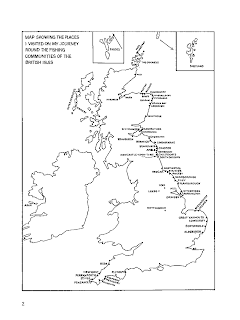Pearson recounts how his method for finding out about the local knitting tradition changed in the researching for this book. Originally, he would arrive at the local tavern, order a pint and then strike up a conversation with a man who was wearing a handknit jumper. He says:
"On spotting a likely candidate, past experience even in those early days had taught me not to blast my way in, tap my chosen target on the shoulder and, by way of introducing myself, explain that I found the pattern on his gansey most intriguing. I also learned never to interrupt that most serious of games—dominoes. Apart from causing the poor fellow to splutter his pint over those dominoes, looking desperately for a way out, this approach somehow reduced the possibility of meeting the knitter, who, of course, was usually his wife. By then, having politely answered my questions (we were, after all, talking about a subject of common interest) it was usually too much for him to continue."
Seriously, what an adorable story! After a few towns, he started phoning ahead to introduce himself to the pub owner, who alerted the gansey-wearing men to Pearson's arrival and created a much more information-sharing friendly environment. And he certainly got a lot of information! Now I know that an entire cottage knitting industry existed, where women and children pumped out incredible amounts of handknitting for sale, and that this knitting industry largely collapsed when knitting machines were invented. I also now know that ganseys were invented because the gansey patterns, which combine knit and purl stitches, used extra wool, hence captured more warmth, which was vitally important for me who were out on a fishing boat all day. These patterns or combinations of stitches were usually family or village specific. Ganseys were knitted in the round on six or eight very long DPNs (which, incidentally, I tried after reading about in this book. I could not do it! I kept stabbing myself with all and could not get into a knitting rhythm.) Sizes were described in terms of how many repeats it would take to go around the torso - so a man might be a "sixteener" or "eighteener" (sixteen or eighteen repeats respectively).
Where possible, Pearson spoke to the knitter or knitter's descendants directly. However, even in the 1980s when this research was conducted, social and cultural changes in these towns meant that the rich local cultures that had previously existed were slowly disintegrating. Houses were being bought by weekenders, who only lived in the towns on the weekends, reducing the vitality of the towns. Additionally, fishing practices had changed, and the hard fishing lifestyle lived by the men and women in these town was often no longer viable. Where there were no knitters remaining, Pearson used archival resources such as local museums and photographs. The photographs of knitters and knitting throughout the book are really fascinating (although only the section on fair isle is in colour).
I like to knit and I like to read but I rarely read books about knitting other than pattern books. Although this book does contain some gansey and fair isle patterns, it is primarily a history rather than a pattern book. Traditional Knitting a fascinating insight into knitting and its history. It was not what I thought it would be when I picked up but I am so pleased to have read it. I know I said I would never knit another jumper but, after finishing this book, I kind of want to knit a gansey... (on a circular needle. I am not completely crazy!)



No comments:
Post a Comment